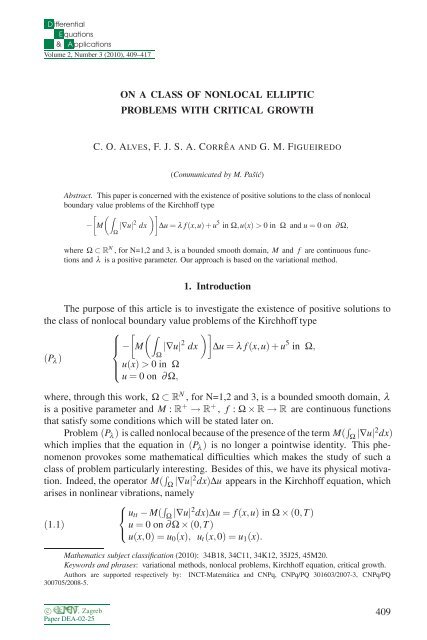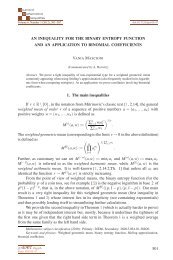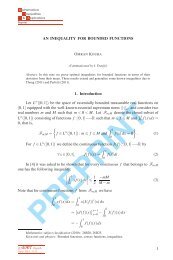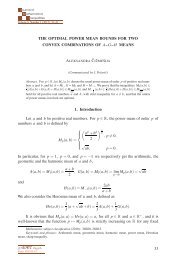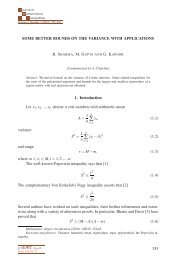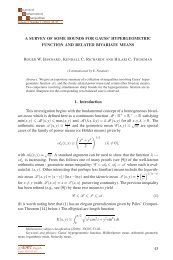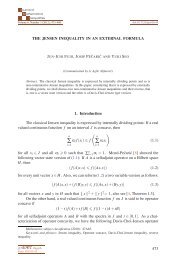On a class of nonlocal elliptic problems with critical growth - Ele-Math
On a class of nonlocal elliptic problems with critical growth - Ele-Math
On a class of nonlocal elliptic problems with critical growth - Ele-Math
You also want an ePaper? Increase the reach of your titles
YUMPU automatically turns print PDFs into web optimized ePapers that Google loves.
D ifferential<br />
E quations<br />
& A pplications<br />
Volume 2, Number 3 (2010), 409–417<br />
ON A CLASS OF NONLOCAL ELLIPTIC<br />
PROBLEMS WITH CRITICAL GROWTH<br />
C. O. ALVES, F.J.S.A.CORRÊA AND G. M. FIGUEIREDO<br />
(Communicated by M. Paˇsić)<br />
Abstract. This paper is concerned <strong>with</strong> the existence <strong>of</strong> positive solutions to the <strong>class</strong> <strong>of</strong> <strong>nonlocal</strong><br />
boundary value <strong>problems</strong> <strong>of</strong> the Kirchh<strong>of</strong>f type<br />
<br />
− M |∇u|<br />
Ω<br />
2 <br />
dx Δu = λ f (x,u)+u 5 in Ω,u(x) > 0in Ω and u = 0on∂Ω, where Ω ⊂ R N , for N=1,2 and 3, is a bounded smooth domain, M and f are continuous functions<br />
and λ is a positive parameter. Our approach is based on the variational method.<br />
1. Introduction<br />
The purpose <strong>of</strong> this article is to investigate the existence <strong>of</strong> positive solutions to<br />
the <strong>class</strong> <strong>of</strong> <strong>nonlocal</strong> boundary value <strong>problems</strong> <strong>of</strong> the Kirchh<strong>of</strong>f type<br />
⎧ <br />
⎪⎨ − M |∇u|<br />
Ω<br />
(Pλ )<br />
⎪⎩<br />
2 <br />
dx Δu = λ f (x,u)+u 5 in Ω,<br />
u(x) > 0in Ω<br />
u = 0on∂Ω, where, through this work, Ω ⊂ R N , for N=1,2 and 3, is a bounded smooth domain, λ<br />
is a positive parameter and M : R + → R + , f : Ω × R → R are continuous functions<br />
that satisfy some conditions which will be stated later on.<br />
Problem (P λ ) is called <strong>nonlocal</strong> because <strong>of</strong> the presence <strong>of</strong> the term M( <br />
Ω |∇u|2 dx)<br />
which implies that the equation in (P λ ) is no longer a pointwise identity. This phenomenon<br />
provokes some mathematical difficulties which makes the study <strong>of</strong> such a<br />
<strong>class</strong> <strong>of</strong> problem particularly interesting. Besides <strong>of</strong> this, we have its physical motiva-<br />
tion. Indeed, the operator M( <br />
Ω |∇u|2 dx)Δu appears in the Kirchh<strong>of</strong>f equation, which<br />
arises in nonlinear vibrations, namely<br />
⎧<br />
⎨ utt − M(<br />
(1.1)<br />
⎩<br />
<br />
Ω |∇u|2dx)Δu = f (x,u) in Ω × (0,T)<br />
u = 0on∂Ω × (0,T)<br />
u(x,0)=u0(x), ut(x,0)=u1(x).<br />
<strong>Math</strong>ematics subject <strong>class</strong>ification (2010): 34B18, 34C11, 34K12, 35J25, 45M20.<br />
Keywords and phrases: variational methods, <strong>nonlocal</strong> <strong>problems</strong>, Kirchh<strong>of</strong>f equation, <strong>critical</strong> <strong>growth</strong>.<br />
Authors are supported respectively by: INCT-Matemática and CNPq, CNPq/PQ 301603/2007-3, CNPq/PQ<br />
300705/2008-5.<br />
c○ Ð ,Zagreb<br />
Paper DEA-02-25<br />
409
410 C. O. ALVES,F.J.S.A.CORRÊA AND G. M. FIGUEIREDO<br />
Such a hyperbolic equation is a general version <strong>of</strong> the Kirchh<strong>of</strong>f equation<br />
(1.2) ρ ∂ 2 <br />
u P0 E L<br />
− + <br />
∂u 2<br />
2<br />
<br />
∂ u<br />
∂t 2 h 2L <br />
0 ∂x dx = 0<br />
∂x2 presented by Kirchh<strong>of</strong>f [9]. This equation extends the <strong>class</strong>ical d’Alembert’s wave<br />
equation by considering the effects <strong>of</strong> the changes in the length <strong>of</strong> the strings during<br />
the vibrations. The parameters in equation (1.2) have the following meanings: L is<br />
the length <strong>of</strong> the string, h is the area <strong>of</strong> cross-section, E is the Young modulus <strong>of</strong> the<br />
material, ρ is the mass density and P0 is the initial tension.<br />
Problem (1.1) began to call attention <strong>of</strong> several researchers mainly after the work<br />
<strong>of</strong> Lions [10], where a functional analysis approach was proposed to attack it.<br />
We have to point out that <strong>nonlocal</strong> <strong>problems</strong> also appear in other fields as, for<br />
example, biological systems where u describes a process which depends on the average<br />
<strong>of</strong> itself (for example, population density). See, for example, [3] and its references.<br />
The reader may consult [2], [3], [7] [8], [11] and [13] and the references therein,<br />
for more informations on (Pλ ).<br />
We will always work in the three-dimensional space R3 , because in the another<br />
dimensions N =1 and 2 everything follows by making standard modifications. Note<br />
that, in the case that we will consider we have 2∗ = 6, which is the well known <strong>critical</strong><br />
Sobolev exponent.<br />
The hypotheses on the function M : R + → R + are the following.<br />
There exists m0 > 0 such that<br />
(M1) M(t) m0 for all t ∈ R + .<br />
There exists θ > 0 such that the function 1<br />
2 M(t 2 ) − 1<br />
[0,+∞),thatis,<br />
(M2)<br />
1<br />
2 M(t 2 ) − 1<br />
θ M(t2 )t 2 0forallt0 θ M(t2 )t 2 is nonnegative in<br />
and<br />
<br />
1 1<br />
(M3)<br />
t 2 M(t 2 ) − 1<br />
θ M(t2 )t 2<br />
<br />
→ +∞ as t → +∞,<br />
<strong>with</strong> 2(1 − H(b)) + 4H(b) < θ < 6, whereH(t)=1ift > 0andH(t)=0ift 0<br />
t<br />
and M(t)= M(s)ds.<br />
0<br />
There exists b 0 such that<br />
M(t)<br />
(M4)<br />
→ b as t → +∞.<br />
t<br />
Note that in the hypothesis (M3), whenb = 0wederive<br />
2(1 − H(b)) + 4H(b)=2
and in the case b > 0, we have<br />
NONLOCAL ELLIPTIC PROBLEMS WITH CRITICAL GROWTH 411<br />
2(1 − H(b)) + 4H(b)=4.<br />
Moreover, from (M4), forallt 0, there exists K > 0 such that<br />
(1.3) M(t) K(m0 + bt).<br />
A typical example <strong>of</strong> a function satisfying the conditions (M1) − (M4) is given by<br />
M(t)=m0 + bt<br />
<strong>with</strong> b 0andforallt 0, which is the one considered in the Kirchh<strong>of</strong>f equation<br />
(1.2).<br />
The hypotheses on function f : Ω × R → R are the following.<br />
f (x,t)<br />
( f1) lim = 0forallx∈Ω, t→0 t<br />
uniformly on x ∈ Ω.<br />
There exists q ∈ (2(1 − H(b)) + 4H(b),6) verifying<br />
( f2) lim<br />
t→+∞<br />
f (x,t)<br />
= 0forallx∈Ω tq−1 and the well known Ambrosetti-Rabinowitz superlinear condition, that is,<br />
t<br />
( f3) 0 < θF(x,t)=θ f (x,s)ds tf(x,t) for all for all x ∈ Ω and t > 0,<br />
0<br />
where θ is given in (M3).<br />
A typical example <strong>of</strong> a function satisfying the conditions ( f1) − ( f3) is given by<br />
f (x,t)=<br />
k<br />
∑<br />
i=1<br />
Ci(x)t qi−1<br />
+<br />
<strong>with</strong> k ∈ N, 2(1 − H(b)) + 4H(b) < qi < 6, Ci ∈ L ∞ (Ω) and t+ = max{t,0}.<br />
The main result <strong>of</strong> this paper is:<br />
THEOREM 1.1. Assume that conditions (M1)-(M4), ( f1)-( f3) hold. Then, there<br />
exists λ ∗ > 0, such that problem (Pλ ) has a weak positive solution in H1 0 (Ω), for all<br />
λ λ ∗ .<br />
We have to point out that these results are new, at least to our knowledge, because<br />
we are treating <strong>with</strong> the Kirchh<strong>of</strong>f equation where the nonlinearity has a <strong>critical</strong><br />
<strong>growth</strong> and we believe that this is the first paper that the condition (M3) appears. We
412 C. O. ALVES,F.J.S.A.CORRÊA AND G. M. FIGUEIREDO<br />
would like to detach that in [7] the authors have considered a <strong>class</strong> <strong>of</strong> <strong>nonlocal</strong> <strong>problems</strong><br />
<strong>with</strong> super<strong>critical</strong> <strong>growth</strong> by using variational methods combined <strong>with</strong> Moser’s iteration<br />
method for λ small enough. In that article, the smallness <strong>of</strong> λ helps to overcome the<br />
difficulty provoked by super<strong>critical</strong> <strong>growth</strong>. However, in the present article the parameter<br />
λ is multiplying the term <strong>with</strong> sub<strong>critical</strong> <strong>growth</strong>. Hence we are working <strong>with</strong> a<br />
different <strong>class</strong> <strong>of</strong> problem and the methods used in [7] can not repeat for this <strong>class</strong> <strong>of</strong><br />
problem. Beside <strong>of</strong> this, we have also considered <strong>class</strong>es <strong>of</strong> functions M , which are not<br />
treated in [7], but still including the one considered by Kirchh<strong>of</strong>f [9]. See, for example,<br />
conditions (M2) and (M3).<br />
2. Preliminary results<br />
Since we intend to find positive solutions, in all this paper let us assume that<br />
f (x,t)=0, ∀x ∈ Ω and t 0.<br />
We recall that u ∈ H 1 0 (Ω) is a weak solution <strong>of</strong> the problem (P λ ) if it verifies<br />
M(u 2 <br />
<br />
<br />
) ∇u∇φ dx− λ<br />
Ω<br />
f (x,u)φ dx−<br />
Ω<br />
u<br />
Ω<br />
5 <br />
+φ dx = 0<br />
for all φ ∈ H1 0 (Ω), whereu2 = |∇u|<br />
Ω<br />
2 dx.<br />
We will look for solutions <strong>of</strong> (Pλ ) by finding <strong>critical</strong> points <strong>of</strong> the C1 -functional<br />
I : H1 0 (Ω) → R given by<br />
Note that<br />
I(u)= 1<br />
2 M(u 2 <br />
) − λ F(x,u) dx−<br />
Ω<br />
1<br />
<br />
u<br />
6 Ω<br />
6 + dx.<br />
I ′ (u)φ = M(u 2 <br />
<br />
<br />
) ∇u∇φ dx− λ<br />
Ω<br />
f (x,u)φ dx−<br />
Ω<br />
u<br />
Ω<br />
5 +φ dx,<br />
for all φ ∈ H 1 0 (Ω), hence <strong>critical</strong> points <strong>of</strong> I are weak solutions for (P λ ). Moreover,<br />
if the <strong>critical</strong> point is nontrivial, by maximum principle, we conclude that is a positive<br />
solution for (P λ ).<br />
In order to use Variational Methods, we first derive some results related to the<br />
Palais-Smale compactness condition.<br />
We say that a sequence (un) is a Palais-Smale sequence for the functional I at the<br />
level d ∈ R if<br />
I(un) → d and I ′ (un)→0in(H 1 0 (Ω)) ′ .<br />
If every Palais-Smale sequence <strong>of</strong> I has a strong convergent subsequence, then<br />
one says that I satisfies the Palais-Smale condition ((PS) for short).<br />
In the sequel, we prove that the functional I has the Mountain Pass Geometry.<br />
This fact is proved in the next lemmas:
NONLOCAL ELLIPTIC PROBLEMS WITH CRITICAL GROWTH 413<br />
LEMMA 2.1. Assume that conditions (M1), ( f1) and ( f2) hold. There exist positive<br />
numbers ρ and α such that,<br />
I(u) α > 0,∀u ∈ H 1 0 (Ω) : u = ρ.<br />
Pro<strong>of</strong>. It follows from (M1), ( f1) and ( f2) that<br />
1<br />
I(u) m0<br />
2 u2 <br />
−Cελ |u|<br />
Ω<br />
q dx− 1<br />
<br />
u<br />
6 Ω<br />
6 + dx.<br />
So, using Sobolev Embedding Theorem, there is a positive constant C > 0 such that<br />
I(u) m0<br />
2 u2 − λCu q −Cu 6 .<br />
Since 2(1 − H(b)) + 4H(b) < q < 6, the result follows by choosing ρ > 0 small<br />
enough. <br />
LEMMA 2.2. Assume that conditions (M3) and ( f3) hold. For all λ > 0, there<br />
exists e ∈ H1 0 (Ω) <strong>with</strong> I(e) < 0 and e > ρ .<br />
Pro<strong>of</strong>. Fix v0 ∈ C∞ 0 (Ω) \{0} <strong>with</strong> v0 0inΩ and v0 = 1. Combining (M4)<br />
and ( f3), weget<br />
I(tv0) K<br />
2 [m0t 2 + b<br />
2 t4 ] − t θ <br />
λ v<br />
Ω<br />
θ <br />
t6<br />
0 dx+ |supp v0|− v<br />
6 Ω<br />
6 0 dx.<br />
Since 2(1 − H(b)) + 4H(b) < θ < 6, the result follows by considering e = t∗v0 for<br />
some t∗ > 0 large enough. <br />
Using a version <strong>of</strong> the Mountain Pass Theorem due to Ambrosetti and Rabinowitz<br />
[4], <strong>with</strong>out (PS) condition (see [14, p.12]), there exists a sequence (un) ⊂ H 1 0 (Ω)<br />
satisfying<br />
I(un) → c∗ and I ′ (un) → 0,<br />
where<br />
and<br />
c∗ = inf<br />
γ∈Γ max I(γ(t)) > 0<br />
t∈[0,1]<br />
Γ := {γ ∈ C([0,1],H 1 0 (Ω)) : γ(0)=0, I(γ(1)) < 0}.<br />
In the following, we devote by S the best constant <strong>of</strong> the Sobolev embedding<br />
H1 0 (Ω) ↩→ L6 (Ω) given by<br />
<br />
<br />
S := inf<br />
|u| 6 <br />
dx = 1 .<br />
|∇u|<br />
Ω<br />
2 dx : u ∈ H 1 0 (Ω),<br />
As in [6] and arguing as in [1], we are able to compare the minimax level c∗ <strong>with</strong> a<br />
suitable number which involves the constant S.<br />
Ω
414 C. O. ALVES,F.J.S.A.CORRÊA AND G. M. FIGUEIREDO<br />
LEMMA 2.3. If the conditions (M1)-(M4) and ( f1)-( f3) hold, then there exist<br />
λ∗ > 0 such that c∗ belongs to the interval (0,( 1<br />
θ<br />
− 1<br />
6 )(m0S) 3/2 ), for all λ λ∗ .<br />
Pro<strong>of</strong>. If v0 is the function given by Lemma 2.2, it follows that there exists tλ > 0<br />
verifying I(tλ v0)=max<br />
t0 I(tv0). Hence<br />
t 2 λ M(t2 λ v0 2 )v0 2 <br />
<br />
= λ<br />
dx. (2.1)<br />
f (x,tλ v0)tλ v0 dx+ t<br />
Ω<br />
6 λ v<br />
Ω<br />
6 0<br />
From (1.3),<br />
Km0v0 2 + t 2 b<br />
λ K<br />
2 v0 4 t 4 <br />
λ v<br />
Ω<br />
6 0 dx,<br />
which implies that (tλ ) is bounded. Thus, there exists a sequence λn → +∞ and t0 0<br />
such that tλn → t0 as n → +∞. Consequently, there is D > 0 such that<br />
and so<br />
t 2 λn M(t2 λn v0 2 )v0 2 D, ∀n ∈ N,<br />
<br />
λn f (x,tλn Ω<br />
v0)tλn v0 dx+ t 6 <br />
λn<br />
v<br />
Ω<br />
6 0<br />
If t0 > 0, the last inequality leads to<br />
<br />
lim<br />
n→∞ λn<br />
f (x,tλn Ω<br />
v0)tλn v0 dx+ t 6 λn<br />
D, ∀n ∈ N.<br />
<br />
Ω<br />
v 6 0 =+∞,<br />
which is an absurd. Thus, we conclude that t0 = 0. Now, let us consider the path<br />
γ∗(t)=te for t ∈ [0,1], which belongs to γ∗ ∈ Γ to get the following estimate<br />
0 < c∗ max<br />
t∈[0,1] I(γ∗(t)) = I(tλ v0) 1<br />
2 M(t 2 λ v0 2 ).<br />
In this way, if λ is large enough, we derive 1<br />
2 M(t 2 λ v0 2 ) < ( 1 1<br />
−<br />
θ 6 )(m0S) 3/2 ,which<br />
leads to<br />
0 < c∗ < ( 1 1<br />
−<br />
θ 6 )(m0S) 3/2 .<br />
<br />
2.1. Pro<strong>of</strong> <strong>of</strong> Theorem 1.1<br />
Pro<strong>of</strong>. From Lemmas 2.1, 2.2 and 2.3, there exists a sequence (un) ⊂ H1 0 (Ω)<br />
verifying<br />
I(un) → c∗ and I ′ (un) → 0<br />
<strong>with</strong> c∗ ∈ (0,( 1 θ − 1 6 )(m0S) 3/2 ) for all λ λ∗ .<br />
From ( f3), thereisC > 0 such that<br />
C + un I(un) − 1<br />
θ I′ (un)un 1<br />
2 M(un 2 ) − 1<br />
θ M(un 2 )un 2 , ∀n ∈ N. (2.2)
NONLOCAL ELLIPTIC PROBLEMS WITH CRITICAL GROWTH 415<br />
Assuming, by contradiction, that (un) is not bounded in H1 0 (Ω), up to a subsequence,<br />
it follows from (M3)<br />
<br />
C 1 1<br />
+ 1 <br />
un un 2 M(un 2 ) − 1<br />
θ M(un 2 )un 2<br />
<br />
→ +∞,<br />
which is an absurd, because the sequence on the left side <strong>of</strong> the inequality is bounded.<br />
Hence (un) is bounded in H 1 0 (Ω) and, up to a subsequence, there is t0 0 such that<br />
Since M is a continuous function, we reach<br />
un→t0. (2.3)<br />
M(un 2 ) → M(t 2 0 ). (2.4)<br />
We claim that un 2 →u 2 as n → ∞, which will imply that un → u in H 1 0 (Ω).<br />
Indeed, by using the fact that I is C 1 , we obtain<br />
and so<br />
I(un) → I(u) and I ′ (un) → I ′ (u)<br />
I(u)=c∗ and I ′ (u)=0.<br />
Thus, the result follows.<br />
It order to prove the claim, taking a subsequence, we may suppose that<br />
|∇un| 2 ⇀ |∇u| 2 + μ and |un| 6 ⇀ |u| 6 + ν (weak ∗ -sense <strong>of</strong> measures).<br />
Using the concentration compactness-principle due to Lions (cf. [12, Lemma 1.2]), we<br />
obtain an at most countable index set Λ, sequences (xi) ⊂ R3 , (μi),(νi) ⊂ [0,∞),such<br />
that<br />
ν = ∑ νiδxi<br />
i∈Λ<br />
, μ ∑ μiδxi<br />
i∈Λ<br />
and Sν1/3<br />
i μi, (2.5)<br />
for all i ∈ Λ,whereδxi is the Dirac mass at xi ∈ Ω.<br />
Now, for every ρ > 0, we set ψρ(x) := ψ((x − xi)/ρ) where ψ ∈ C ∞ 0 (Ω,[0,1])<br />
is such that ψ ≡ 1onB1(0), ψ ≡ 0onΩ \ B2(0) and |∇ψ|∞ 2. Since (ψρun) is<br />
bounded, I ′ (un)(ψρun) → 0, that is,<br />
M(un 2 <br />
) ∇un · ∇ψρ dx = −M(un<br />
Ω<br />
2 <br />
) ψρ|∇vn|<br />
Ω<br />
p <br />
dx<br />
<br />
+ λ f (x,un)ψρun dx+<br />
Ω<br />
ψρ|un|<br />
Ω<br />
6 dx+ on(1).<br />
Recalling that M(un2 ) converges to M(t 2 0 ), we can argue as in [5] to show that<br />
lim[<br />
lim<br />
ε→0 n→∞ M(un 2 <br />
) ∇un · ∇ψρ dx]=0.<br />
Ω
416 C. O. ALVES,F.J.S.A.CORRÊA AND G. M. FIGUEIREDO<br />
Moreover, since un → u in Ls (Ω) for all 1 s < 6andψρhas compact support, we<br />
can let n → ∞ in the above expression to obtain<br />
<br />
ψρdν M(t 2 0 )ψρdμ.<br />
Ω<br />
Ω<br />
Letting ρ → 0 we conclude that νi M(t 2 0 )μi m0μi . It follows from (2.5) that<br />
νi (m0S) 3/2 ( 1 1<br />
−<br />
θ 6 )(m0S) 3/2 . (2.6)<br />
Now we shall prove that the above expression cannot occur, and therefore the set<br />
Λ is empty. Indeed, arguing by contradiction, let us suppose that νi ( 1 θ − 1 3/2<br />
6 )(m0S)<br />
for some i ∈ Λ. <strong>On</strong>ce that (un) is a (PS)c∗ ,wehave<br />
c∗ = I(un) − 1<br />
θ I′ (un)un + on(1).<br />
From (M2), wederivethat 1<br />
2 [ M(un 2 ) − 1<br />
θ M(un 2 )un 2 ] 0foralln∈N, hence<br />
c∗ ( 1 1<br />
−<br />
θ 6 )<br />
<br />
|un|<br />
Ω<br />
6 dx+ on(1) ( 1 1<br />
−<br />
θ 6 )<br />
<br />
ψρ|un|<br />
Ω<br />
6 dx+ on(1).<br />
Letting n → ∞, weget<br />
c∗ ( 1 1<br />
−<br />
θ 6 ) ∑ ψρ(xi)νi =(<br />
i∈Λ<br />
1 1<br />
−<br />
θ 6 ) ∑ νi (<br />
i∈Λ<br />
1 1<br />
−<br />
θ 6 )(m0S) 3/2 ,<br />
which does not make sense. Thus Λ is empty and it follows that un → u in L6 (Ω).<br />
Since un → u in L q (Ω), we conclude<br />
lim<br />
n→∞ M(un 2 )un 2 <br />
= λ<br />
Ω<br />
<br />
f (x,u)u dx+ u<br />
Ω<br />
6 + dx.<br />
<strong>On</strong> the other hand, by using well known arguments, we reach<br />
M(t 2 <br />
<br />
<br />
0) ∇u∇φdx = λ f (x,u)φdx+ u 5 φdx, ∀φ ∈ H 1 0 (Ω)<br />
Ω<br />
and so<br />
M(t 2 0 )u2 <br />
<br />
= λ f (x,u)udx+<br />
Ω<br />
u<br />
Ω<br />
6 from where if follows that<br />
dx<br />
Ω<br />
M(un 2 )un 2 → M(t 2 0)u 2 .<br />
From (2.4), the pro<strong>of</strong> <strong>of</strong> claim is complete. <br />
Acknowledgements. Part <strong>of</strong> this work was done while the second author was visiting<br />
the Departamento de Análisis Numérico y Ecuaciones Diferenciales - Universidad<br />
de Sevilla, Grant CNPq 201214/2008-3. The third author would like to thank<br />
UAME/UFCG - Campina Grande, and specially to Pr<strong>of</strong>essor Claudianor Oliveira Alves<br />
for his attention and friendship. This work was done while he was visiting that institution.<br />
Ω
NONLOCAL ELLIPTIC PROBLEMS WITH CRITICAL GROWTH 417<br />
REFERENCES<br />
[1] C. O. ALVES, Existence <strong>of</strong> radial solutions for a <strong>class</strong> <strong>of</strong> p(x)-Laplacian equations <strong>with</strong> <strong>critical</strong><br />
<strong>growth</strong>, to appear in Diff. Int. Eq., (2009).<br />
[2] C. O. ALVES, F.J.S.A.CORRÊA, <strong>On</strong> existence <strong>of</strong> solutions for a <strong>class</strong> <strong>of</strong> problem involving a<br />
nonlinear operator, Comm. Appl. Nonlinear Anal., 8 (2001), 43–56.<br />
[3] C. O. ALVES, F.J.S.A.CORRÊA, T.FMA, Positive solutions for a quasilinear <strong>elliptic</strong> equation <strong>of</strong><br />
Kirchh<strong>of</strong>f type, Comput. <strong>Math</strong>. Appl., 49 (2005), 85–93.<br />
[4] A. AMBROSETTI,P.H.RABINOWITZ, Dual variational methods in <strong>critical</strong> point theory and apllications,<br />
J. Functional Analysis, 14 (1973), 349–381.<br />
[5] J.G.AZORERO, I.P.ALONSO, Multiplicity <strong>of</strong> solutions for <strong>elliptic</strong> <strong>problems</strong> <strong>with</strong> <strong>critical</strong> exponent<br />
or <strong>with</strong> a nonsymmetric term, Trans. Amer. <strong>Math</strong>. Soc. , 323, 2 (1991), 877–895.<br />
[6] H. BREZIS, L.NIRENBERG, Positive solutions <strong>of</strong> nonlinear <strong>elliptic</strong> equations involving <strong>critical</strong><br />
Sobolev exponents, Comm. Pure Appl. <strong>Math</strong>., 36 (1983), 437–477.<br />
[7] F.J.S.A.CORRÊA, G.FIGUEIREDO, <strong>On</strong> an <strong>elliptic</strong> equation <strong>of</strong> p-Kirchh<strong>of</strong> type via variational<br />
methods, Bull. Aust. <strong>Math</strong>. Soc., 74, 2 (2006), 263–277.<br />
[8] F.J.S.A.CORRÊA, S.D.B.MENEZES, Existence <strong>of</strong> solutions to <strong>nonlocal</strong> and singular <strong>elliptic</strong><br />
<strong>problems</strong> via Galerkin method, <strong>Ele</strong>ctron. J. Differential Equations, (2004), 1–10.<br />
[9] G. KIRCHHOFF, Mechanik, Teubner, Leipzig, 1883.<br />
[10] J. L. LIONS, <strong>On</strong> some questions in boundary value <strong>problems</strong> <strong>of</strong> mathematical physics, International<br />
Symposium on Continuum, Mechanics and Partial Differential Equations, Rio de Janeiro (1977),<br />
<strong>Math</strong>ematics Studies, Vol. 30, North-Holland, Amsterdam, (1978), 284–346.<br />
[11] T. F. MA, Remarks on an <strong>elliptic</strong> equation <strong>of</strong> Kirchh<strong>of</strong>f type, Nonlinear Anal., 63, 5-7 (2005), 1967–<br />
1977.<br />
[12] P. L. LIONS, The concentration-compactness principle in the calculus <strong>of</strong> variations. The limit case,<br />
Rev. Mat. Iberoamericana, 1 (1985), 145–201.<br />
[13] K. PERERA,Z.ZHANG, Nontrivial solutions <strong>of</strong> Kirchh<strong>of</strong>f-type <strong>problems</strong> via the Yang index, J. Differential<br />
Equations, 221 (2006), 246–255.<br />
[14] M. WILLEM, Minimax Theorems, Birkhäuser, 1996.<br />
(Received December 22, 2009) Claudianor O. Alves and Francisco Julio S. A. Corrêa<br />
Departamento de Matemática e Estatística<br />
Universidade Federal de Campina Grande<br />
CEP: 58109-970, Campina Grande - Pb<br />
Brazil<br />
e-mail: coalves@dme.ufcg.edu.br<br />
e-mail: julio@dme.ufcg.edu.br<br />
Giovany M. Figueiredo<br />
Faculdade de Matemática<br />
Universidade Federal do Pará<br />
CEP: 66075-110 Belém - Pa<br />
Brazil<br />
e-mail: giovany@ufpa.br<br />
Differential Equations & Applications<br />
www.ele-math.com<br />
dea@ele-math.com


